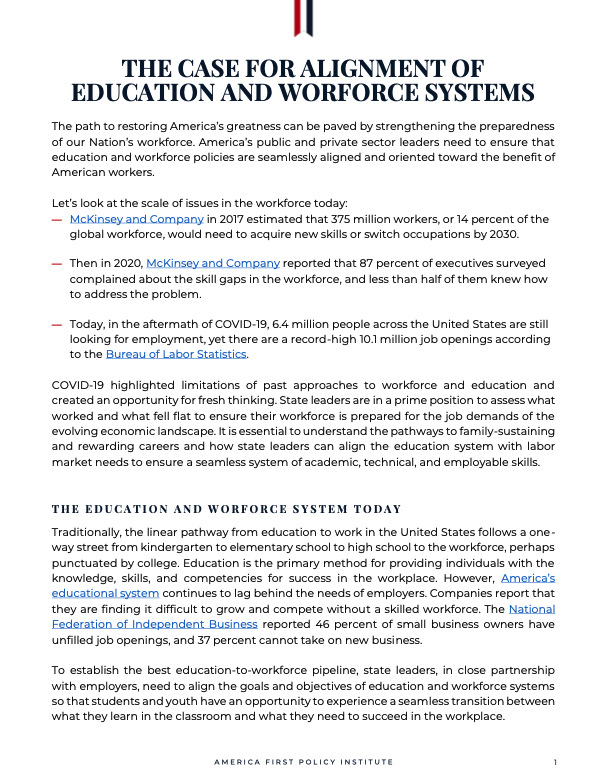Two-Pager - The Case for Alignment of Education and Workforce Systems
The path to restoring America’s greatness can be paved by strengthening the preparedness of our Nation’s workforce. America’s public and private sector leaders need to ensure that education and workforce policies are seamlessly aligned and oriented toward the benefit of American workers.
Let’s look at the scale of issues in the workforce today:
— McKinsey and Company in 2017 estimated that 375 million workers, or 14 percent of the
global workforce, would need to acquire new skills or switch occupations by 2030.
— Then in 2020, McKinsey and Company reported that 87 percent of executives surveyed complained about the skill gaps in the workforce, and less than half of them knew how to address the problem.
— Today, in the aftermath of COVID-19, 6.4 million people across the United States are still looking for employment, yet there are a record-high 10.1 million job openings according to the Bureau of Labor Statistics.
COVID-19 highlighted limitations of past approaches to workforce and education and created an opportunity for fresh thinking. State leaders are in a prime position to assess what worked and what fell flat to ensure their workforce is prepared for the job demands of the evolving economic landscape. It is essential to understand the pathways to family-sustaining and rewarding careers and how state leaders can align the education system with labor market needs to ensure a seamless system of academic, technical, and employable skills.
THE EDUCATION AND WORFORCE SYSTEM TODAY
Traditionally, the linear pathway from education to work in the United States follows a one- way street from kindergarten to elementary school to high school to the workforce, perhaps punctuated by college. Education is the primary method for providing individuals with the knowledge, skills, and competencies for success in the workplace. However, America’s educational system continues to lag behind the needs of employers. Companies report that they are finding it difficult to grow and compete without a skilled workforce. The National Federation of Independent Business reported 46 percent of small business owners have unfilled job openings, and 37 percent cannot take on new business.
To establish the best education-to-workforce pipeline, state leaders, in close partnership with employers, need to align the goals and objectives of education and workforce systems so that students and youth have an opportunity to experience a seamless transition between what they learn in the classroom and what they need to succeed in the workplace.
AMERICA FIRST POLICY INSTITUTE 1
The unnecessary bureaucracy and fragmentation created by the federal government operating more than 40 workforce development programs across 15 agencies make it difficult for state and local efforts to meet the needs of the citizens and focus on in-demand skills. While combining workforce and education systems is certainly not a new concept, successfully implementing it is critical to preparing Americans for success through family- sustaining careers. As states begin to address the skills gap, it is natural to review the workforce development system and leverage workforce system training funds with money from other federal and state systems. Consolidating states’ efforts would help to increase the efficiencies for the American worker.
HOW TO BETTER ALIGN EDUCATION AND WORKFORCE SYSTEMS
There needs to be active engagement with employers to ensure programs prepare workers with the skills necessary to succeed.
States could align goals and collaborate with the private sector to help create inclusive and supportive pathways for people to develop skills, earn credentials, and enter careers.
It is important for state leaders and policymakers to align K-12 education, postsecondary, workforce development, and economic development systems that alleviate barriers for American workers.
Policymakers can support skills-based education and employment infrastructure through competency-based education—an innovative approach designed to help students and workers meet specific skills and competencies that industry leaders, workforce representatives, and faculty approve.
Private sector and policymakers can implement and prioritize learning employment records that list individual skills and credentials and ensure the records are recognized across educational institutions, workforce systems, and employers.
Educating parents—key drivers of education decisions and career pathways—about the importance of aligning education and workforce systems could help with the success of these efforts.
There is great opportunity through youth apprenticeship programs offered by states to provide real-world opportunities for students to earn money while they acquire on-the-job skills and get a head start on their careers.
AMERICA FIRST POLICY INSTITUTE 2
